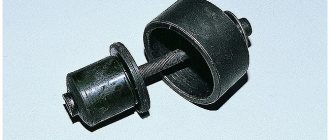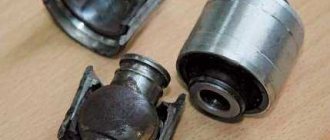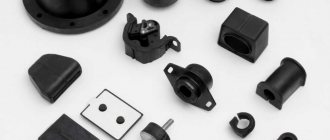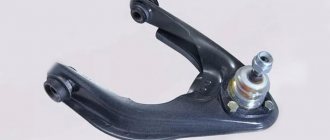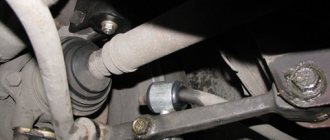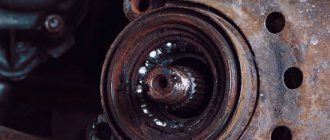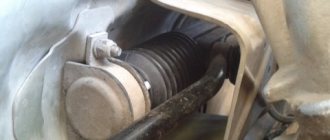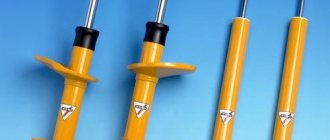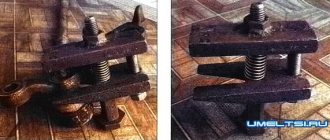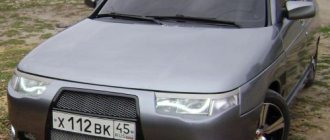Replacement methods
We will tell you about two main ways to replace silent blocks on the rear beam of the “tens”, which can easily be used in a garage.
Which method to choose is up to you to decide. But before that, familiarize yourself with them in more detail.
First way
The method is not particularly difficult if you strictly follow the instructions. To begin with, we note that the silent block is located at the bottom of the car. Therefore, you will need a jack or inspection hole.
Defects
- Raise the car with a jack or drive it into a viewing hole. The second option is more convenient, since this way the view of the bottom will be better. And it’s much more convenient to work standing up than lying under a car.
- It is not necessary to completely remove the rear beam. When dismantling it, you will need to remove additional brake hoses, which takes a lot of time.
- It is better to disconnect the sorcerer so as not to damage it during the repair process. But shoot carefully.
- Now remove the nut with a 19mm wrench. You will have to make a serious effort, which is why some car owners call their comrades for help. If there are no assistants, pre-treat the thread with the almighty WD40 or plain water. This will allow the fastener to oxidize. Then clean it with a wire brush, which will make it easier to remove the element.
- Using a crowbar, lower the beam down a little, but do not remove it completely.
- There is an elastic band on the beam that should be cut off, otherwise it will interfere with the work process. Just keep in mind that if the rubber band is old, feel free to remove it. It is better to dismantle a good product by drilling a small hole.
- Now the silent block is removed.
- The new part is generously lubricated and pressed into its rightful place. Just do not use grease for lubrication, as this substance corrodes the part. The best lubrication option is regular soap or any available detergent.
- Return the sorcerer to its place and tighten the beam.
https://youtube.com/watch?v=nM2tgU95DGo
Second way
The second option for replacing the silent block is even simpler. But he also has his tricks.
Easy way
- Raise the car on a jack or drive it into a viewing hole.
- Using the same 19 mm wrench, remove the fastening nuts on the rear beam. This will allow you to detach the beam from the bracket.
- Remove the unscrewed bolt and move the rear beam eye down slightly.
- To make work easier, insert a wooden beam between the beam and the body, approximately the same size as a regular building brick.
- Remove the silent block by hitting it with a hammer.
- Lubricate the new block with something slippery, which will allow the element to do its job better.
- Press the silent block into its place.
- Remove the inserted beam and return the beam to its original position, securing it with fasteners.
At this point, the procedure for replacing the silent block of the rear beam of your domestic “ten” produced by AvtoVAZ can be considered complete.
https://youtube.com/watch?v=Xu2_Vq7X7SI
Both methods allow you to independently, without unnecessary problems, resolve the issue of a failed silent block. Just in case, don’t forget to call a friend in the garage who will help you at the most difficult stages.
Loading …
Replacing consumables, eliminating axial play
Having dismantled the suspension elements, you can begin to press out the worn silent blocks and install new ones.
Using a special device prepared in advance, old silent blocks are removed from the crossbar, levers and racks and new ones are pressed into their place.
To facilitate installation, new consumables can be moistened with soapy water.
But the use of petroleum-based lubricants is not recommended, since they have a negative effect on rubber elements.
Regarding the stabilizer struts, before pressing out, they will need to be knocked off the stabilizer, since they are tightly seated on it.
When knocking down, it is better to use a hammer and strike through a wooden spacer.
Also, after removing the struts, the rubber bushings are pulled off the stabilizer and new ones are installed in their place.
Often a phenomenon called axial play occurs at the lower arm.
It is formed when the body bracket to which the lever is attached, for one reason or another, loosened and a gap appeared between it and the metal bushing of the silent block, which is why the silent block itself was able to move along the fastening bolt.
This axial play negatively affects the performance of the suspension, so it should not exist. But if it appears, then there are two ways to eliminate it.
You can try to compress the bracket. But this is very difficult to do, since it is better not to apply impact with a hammer, even through a spacer, and using clamps or a vice is not very convenient.
It is much easier to get rid of axial play using washers that are placed between the bracket and the silent block.
But according to the manual, it is recommended to replace the entire lower control arm with joints
After replacing all consumables, the removed suspension elements are installed in place.
After replacing all the silent blocks on the front suspension, the vehicle must have its wheel alignment angles adjusted.
Replacing silent blocks on a VAZ-2110 with your own hands
Over time, under the influence of loads and the influence of an aggressive external environment, they become unusable and require replacement.
Let's look at how to replace silent blocks on a VAZ-2110 car on your own, without contacting a car service.
Where are the silent blocks located on the VAZ-2110
The main task of silent blocks is to soften shock loads that are transmitted to the car body from the suspension, engine or gearbox.
In a VAZ-2110 car, such hinges are installed in:
- elastic shock absorber mounting points;
- jet rod fastening elements;
- upper arms (popularly called “sabers”);
- elements of fastening of the stabilizer cross member;
- support beams for mounting the engine and gearbox;
- rear suspension rod elements.
Most often, the front suspension silent blocks and stretch bands (popularly called “daisies”) require replacement, since they experience the greatest loads here.
Signs of wear
During operation, silent compounds are exposed to reagents used on winter roads, dirt and large temperature changes. The rubber-metal hinge loses its elasticity over time, cracks and wears out.
Theoretically, the resource of silent blocks is 100,000 kilometers. However, they have to be changed (they cannot be repaired) much more often, every 50,000 kilometers.
How can you open a VAZ-2110 without a key?
Some of the signs that silent blocks need to be replaced are:
- the appearance of extraneous creaks and knocks in the area of the vehicle’s chassis;
- play of levers and wheels;
- uneven tire wear;
- loss of stability of the car on the road, difficulties in controlling it (the car seems to become “wobbly”);
- Upon visual inspection of silent blocks cleared of dirt, cracks and damage to the rubber are detected.
An indirect sign is considered to be a violation of the camber/toe of the car's wheels, if it is known that it was previously adjusted.
Polyurethane or rubber, which is better?
It is better to replace standard rubber bushings with polyurethane ones, then they will last much longer. Polyurethane hinges improve the car's behavior on the track and reduce unwanted deformations in the connections of suspension elements.
Polyurethane hinges are better than rubber ones at absorbing suspension shocks, vibrations and reducing noise when the car is moving. Their only drawback is their relatively high cost, but the increased service life of the products offsets this difference in price.
Replacing silent blocks
The general principles for replacing rubber-metal hinges are the same for all elements. First of all, they need to be freed from all fastenings. If it is possible to remove the part with the silent block, then replacing them will be much more convenient.
Then you need to press out the silent itself. This is often quite difficult to do. It is better to press out and install new silent blocks using a special squeezing device.
If there is none, then the easiest way is to cut off one of the hinge shoulders and knock out its remains with a drift. It’s time to use the old “old-fashioned” method - burn out the rubber element.
Before installation, be sure to lubricate the surface of the part with liquid soap or soap solution; you can chamfer one of the collars.
Do I need to do a wheel alignment after this?
Of course, after replacing the vehicle's engine or gearbox mounts, after repairing a non-adjustable rear axle (for example, a torsion beam), or replacing stabilizer struts, such wheel adjustment will not be necessary.
But if the hinges of the front axle, adjustable steering rack or rear rack have been replaced, then such an adjustment is necessary, since previous adjustments were made taking into account the wear of the silent blocks. What are the consequences of untimely replacement of these hinges? When these joints wear out too much, the car loses its controllability: it is pulled off the road at speed or “thrown” from side to side. This is fraught with emergency situations. Over time, the hinge seats may collapse, which will require the replacement of more expensive parts.
Polyurethane silent blocks, what is the advantage
The service life of the hinge is influenced by a number of other circumstances. For example, the rubber used in the silent block design is very badly affected by petroleum products and chemicals used to treat the road surface in winter. Temperature changes also have an extremely negative effect on the part - in the summer the rubber softens, and in the winter it begins to freeze and becomes too hard. Under conditions of severe mechanical loads, rubber begins to wear out, “age”, lose elasticity, delaminate, and fail.
Silent blocks with elastic elements made of polyurethane performed much better under equal conditions.
Polyurethane hinges have much better performance characteristics than their counterparts with rubber inserts. They are less destroyed by chemicals, retain elasticity regardless of the ambient temperature, and polyurethane is practically unaffected by petroleum waste. Of course, a polyurethane silent block will last much longer than a rubber one. However, like any part, over time it requires replacement because it begins to age and delaminate.
Reasons for replacement and self-installation of VAZ 2110 silent blocks
Experienced car owners, of course, know that it is the silent blocks on the VAZ 2110 that affect the wheel alignment angles. And for new car enthusiasts, this may be news, but it encourages the idea that the condition of these parts needs to be monitored.
Set of silent blocks and bushings. Article 17-21-004
When should you change?
Usually, the driver will probably guess that the silent block has failed. If a replacement is needed, discomfort while driving will tell you about it. You can feel distinct “iron” impacts and noises in the suspension. But that's not all.
If urgent measures are not taken, the VAZ 2110’s fastenings and connections will break and play will appear. The wheel alignment angles will also suffer, which obviously will not lead to any good.
Worn silent block
There are some symptoms to look out for that these rubber parts are worn out:
- When driving, the tires on the wheels squeak. Not necessarily much. There shouldn't even be a slight squeak;
- A knocking sound is heard in the wheel area. The point here is the poor rotation of the collapsing silent blocks;
- As the silent block wears out, it first becomes covered with cracks and then completely falls apart. Here only the deaf can no longer hear the knocks.
You can find out the overall and geometric dimensions of the VAZ 2110 body in this material: https://vazweb.ru/desyatka/kuzov/geometricheskie-razmery-kuzova.html
DIY replacement
Even in an ordinary garage, high-quality replacement of silent blocks is possible. To do this, you only need to have a puller, which you can make yourself, having a simple drawing. Or you can borrow it from your motorist friends.
Silent block remover
Such a device will become an assistant when removing and then further installing new silent blocks. It consists of two tubes and washers. The length of the puller legs is about 20 cm.
Some, having adapted, make do with a mandrel.
Front suspension
For the front suspension, silent blocks are provided: front beam, upper, lower arm.
Replacement for parts of the front upper arm of the VAZ 2110 occurs as follows:
- You need to jack up and secure the car;
- Remove the front wheel;
- Unscrew and knock out the support. To do this, hit the bipod with a hammer, turning the wheel out;
- Once the support is knocked out, it becomes possible to remove the upper front control arm. To do this, unscrew a long bolt from the side. At the same time they look at the axial play. If it is palpable, replacement may be warranted;
- Removing the silent tape is quite simple using a chisel and a hammer. The main thing is to accurately calculate the impact in order to avoid damage to other parts. Sometimes very “stubborn” silent blocks have to be drilled out and only then knocked out;
- You can press in a new silent block by pressing it into the socket using a smaller bushing until it sits securely there.
Replacing the silent blocks of the front lower control arms of a VAZ 2110 is a more difficult task; to complete it, you will need:
- Remove the stabilizer so that the lever can be moved;
- Unscrew the nuts holding the silents;
- Remove the rubber bushings (same as in the case of the upper arm);
- Press in new ones, and then be sure to fix them in the loaded state of the VAZ 2110.
You can read more about the front beam malfunctions in this material: https://vazweb.ru/desyatka/podveska/perednyaya-balka.html
Tools and accessories
There are not so many tools that will be required to replace all consumables, but some of them are specific.
- Set of keys, heads, knobs;
- A set of new oil seals and bushings;
- Device for pressing out and pressing in silent blocks;
- Puller for ball joint;
- Jack;
- Stops;
- Vise;
- Hammer and wooden spacers;
- Soap solution.
Device for pressing out and pressing in silent blocks.
You can buy it or make it yourself.
The simplest homemade device consists of a long bolt with a nut, pieces of pipe with different diameters and several thick washers.
The principle of operation of such a device is very simple.
To press out the silent block, take a bolt and put a washer on it, the size is slightly smaller than the diameter of the rubber part of the silent block.
The bolt is passed through the bushing of the silent block. On the other hand, a piece of pipe with a diameter equal to the diameter of the seat, for example, a lever, is thrown onto the bolt.
That is, the pipe will have to rest against the circumference of the seat in the lever.
Next, another washer is put on the bolt, its circumference larger than the diameter of the pipe, and then the nut is screwed on.
Pressing out is done like this: the nut, when screwed on, will pull towards itself the washer resting on the silent block.
The installed tube will allow it to come out of the seat and not rest against another washer.
Pressing is done in exactly the same way, with the only difference that it is not necessary to use a piece of pipe, since the silent block will rest against the thrust washer when it sits in place.
You can even press-fit without using a device; it is enough to have only a vice, between the jaws of which a new silent block and lever are installed, so that it and its seat are on the same axis.
Next, the vice compresses and the consumable itself falls into place. But in this way you can install silent blocks only on the lever and stabilizer struts, but on the cross member you will still need a device for replacement.
Purpose and location of silent blocks
The word “silent blocks” comes from foreign cars; previously these elements were called rubber-metal hinges. The part is a connection of two metal tubes, between which there is a rubber insert. Silent blocks are installed in the rear and front suspension. The task of these elements is to change the angles of the wheels of the VAZ 2110. They are also the unifying parts of the suspension and dampen vibrations that appear during driving.
In this material, we will examine the replacement of silent blocks in the front suspension, since here they are subject to heavy loads, as a result, the rubber rubs and the tubes wear out. These VAZ 2110 parts are installed on the rear and front control arms. The joints are also used as mounts for the engine, gearbox and shock absorbers. The replacement can be done independently if you have an inspection hole and a jack.
Signs of trouble
It is quite easy to determine that silent blocks are the cause of a malfunctioning front suspension. Signs of malfunction of these parts are as follows:
- From under the front wheels of the VAZ 2110 you can hear an unnatural squeak of rubber, which differs from the noise made by the wheels.
- A knocking sound appears in the front of the car. This occurs due to wear of the rubber-metal hinges, which stop sliding, resulting in noise.
- The fault can also be determined by visual inspection - cracks, tears and other defects appear on the rubber.
- If these signs appear, it is necessary to remove the hinges from the rear and front arms and inspect them for damage. Metal rubber-metal hinges cannot be repaired, so replacement of new parts is required.
Replacing the silent blocks of the upper arm
Replacing silent blocks on the front arms of a VAZ 2110.
Their replacement involves the following steps:
- Raise the car on a jack and secure it.
- Remove the front wheel.
- Remove the upper arm. However, before doing this, you need to carefully look to see if the silent blocks in the lever are slipping. They must be stationary.
Replacing the silent blocks of the front levers of a VAZ 2110
To make it easier to remove the upper arm, you need to knock out the upper support. To do this, unscrew the support nut.
Note: it is quite difficult to unscrew, but without this the support will remain in place.
You need to turn the wheel by hitting the bipod with a hammer. Only after this the support will pop out.
Replacing silent blocks of front levers on a VAZ 2110
Then you should unscrew the lever bolt located on top.
Note: It is quite long, so unscrewing it may take a long time.
- This bolt needs to be pulled out, which will allow you to remove the machine arm.
- You can start replacing them.
Note: the problem may be not only in the silent blocks, but also in the lever. To check if it is working properly, you need to put the lever bolt in place and see if there is a lot of axial play.
If it is large, then the problem with silent blocks may occur again. Therefore, before inserting a new one, you need to repair the lever.
Replacing silent blocks on the front beam of a VAZ 2110
- You can remove the silent blocks using a hammer or chisel. In fact, they fall out almost after the first hit. The main thing is not to damage the car.
- Now you need to insert the new silent block where the old one was. You need to press it in properly so that it does not dangle. You can press it in easily: one bushing fits the size of the silent block skirt, the other is a little larger. By pressing with the smaller bushing, it easily fits into the lever.
Replacing the silent blocks of the front beam of a VAZ 2110
Repair of axial play
There are two repair options:
- Replace the entire pole completely. However, not only is it very expensive, but its quality is not the best.
- You can tighten two washers on the sides so that the bolt cannot dangle.
Note: screwing in these washers may result in the silent blocks not fitting into the lever, so they will need to be shortened slightly using a hacksaw. This can significantly reduce the service life of silent blocks.
Replacing the lower arm silent block
The lower silent blocks are a little more difficult to replace:
- First you need to remove the stabilizer, which will allow you to move the lever left and right.
- Now you need to unscrew all the nuts that hold the silent block stationary.
- You need to remove the lower control arm silent blocks. To do this, you need to repeat all the steps as with the silent blocks of the upper arm.
- Now you can start pressing in new silent blocks.
Note: they can only be fixed when the vehicle is loaded. After all, if you fix them on a suspended suspension, they may soon fail.
High-quality photos, a corresponding video or instructions will help everyone complete the work of replacing the front silent block with their own hands. However, you need to be extremely careful, because you can do a lot of damage to your car. This will result in you having to pay in
Didn't find the information you are looking for? on our forum.
We recommend reading:
How to remove the head on a VAZ 2109
VAZ 2101 car engine. Technical characteristics, maintenance, modernization
VAZ 2114 has a bad cold start. Why might it be difficult to start?
Replacing a radiator heater on a VAZ 2114
LED taillights for VAZ 2110
VAZ 2114 stalls after releasing gas
Replacing the windshield on a VAZ 2107, what is needed for replacement, removal and installation
Operating temperature of the VAZ 2115 engine, 8 valves, injector
The following components are also required:
- Silent block remover for removing the upper control arm from the car;
- Steering end remover, without which it is impossible to unpress the outer steering ends
Most likely, if you decide that you can replace silent blocks on a VAZ 2107 yourself, then you have the rest of the tools. These should be elements such as:
- Jack;
- Socket and open-end wrenches 22;
- Socket and socket wrenches 13;
- Thin, well-sharpened chisel;
- Hammer;
- Mount.
All of the above has most likely convinced you that silent blocks are a very important component of the car. Only one conclusion follows from this - you should not skimp on buying high-quality branded silent blocks. You can also use polyurethane components, but the cost may leave you a little shocked.
So, after all the tools and parts for replacement are prepared, you should start with a process such as replacing the front silent blocks.
- Loosen the wheel bolts and lift the required wheel using a jack. After this, immediately remove it and loosen the nut on the axis of the upper arm using a 24mm wrench. You can immediately unscrew the steering tip nut and unpress it.
- At the next stage, unscrew the upper ball joint nut using a 24mm wrench. Using a puller, unpress the support pin from the bipod. If there is no puller, simply unscrew the support from the lever using several 13mm wrenches.
- Unscrew the upper arm eye nut and remove it. It is noteworthy that replacing silent blocks involves unscrewing the vertical bolt securing the bumper.
- The next step is to drag the lever to the workbench and clamp it in a vice. Now you should press out the silent blocks with a previously purchased device. Next comes the installation of the front arm silent blocks. Next, install the lever in place, having previously processed the axis of the upper lever. For this you can use nigrol, lithol, motor oil. It is not recommended to tighten the axle nut completely. Tightening is carried out with the vehicle completely lowered.
- Secure the support, put on and secure the wheel, and lower the car from the jack.
Next, prepare a set of silent blocks to carry out such a process as replacing the silent blocks of the rear levers. First of all, you should remove the silent blocks of the rear control arms from the VAZ 2107.
- Remove the wheel from the car;
- Unscrew the lever axle nuts on both sides using a 22mm wrench and remove the thrust washers.
- Screw the complete puller bolt onto the lower arm axle. Tighten the nut while holding the bolt from turning. The puller glass, at the same time, presses on the lower lever, pressing it from the silent block.
- The next step is to remove the silent block from the lower arm.
- On the opposite side of the rear lever axis, the silent block is pressed out in the same way.
Next, the rear silent blocks are directly replaced:
- The new silent block must be centered in the hole of the lower arm;
- To prevent the lower arm of the silent block from moving relative to the axle during pressing, a thrust washer should be placed on the axle on the opposite side and the old self-locking nut should be screwed in.
- Install the puller onto the lower arm axle and tighten the nut. The puller glass should press on the silent block flange. If you didn’t know how to press in a silent block, then this is how it’s done. It is worth noting that when pressing in, a glass of smaller diameter must be installed on the silent block remover than when pressing out.
- Release the puller by unscrewing the screw. Next, install the thrust washer on the axle and tighten the new nut without tightening it.
- In the same way, press in the silent block on the opposite side of the lower arm and screw in a new nut, installing a washer.
- Finally tighten the nuts on the lower control arm after installing the vehicle on the wheels.
In general, this process is not particularly simple, but if you follow the step-by-step instructions, it will be easy to do, just like repairing shock absorbers yourself. The subframe silent blocks are also replaced in a similar manner. Don't forget to reinstall the tie rod ends and then tighten them. The next step is to tighten the lower and upper arm nuts after the machine is completely lowered to the ground.
Suspension design features
Cars use different types of suspension structures, so the installation locations and the number of silent blocks are different.
For example, classic VAZ models (2101-2107) are equipped with a double-wishbone front suspension, including upper and lower A-arms.
Below is the front suspension of the VAZ 2107.
Each of them has two hinges, on the side where the lever is attached to the car body. But the upper element is secured with a long bolt, and the lower one is mounted on the lever axis, screwed to the body. On the other side, the levers have ball joints.
But in more modern models, starting from the VAZ-2108 and ending with the VAZ-2115, only one lower lever is used.
Below is the front suspension of the VAZ 2109.
There are 2 silent blocks installed in it - at the place of fastening to the body bracket and at the junction of the lever with the spacer.
Another rubber-metal hinge is used on the other side of the spacer, where it is connected either to the mounting bracket (VAZ 2108-21099, VAZ 2113-2115) or to the cross beam (VAZ 2110-2112).
Since the suspension designs are different, the algorithm for replacing silent blocks is different. But in general, this procedure is quite doable in a garage environment, so it is not necessary to contact the service to replace silent blocks.
Installation of “daisies” in the front suspension beam of a VAZ
On the VAZ 2110 (and some other front-wheel drive cars), rubber silent blocks are used in the cross member of the front suspension. To change the characteristics of the suspension and handling, they can be replaced with rubber-metal hinges (popularly “daisies”). Let's look at this improvement in detail.
Replacing silent blocks of the front suspension cross member
It is more convenient to replace silent blocks on a removed beam; for this you should:
- We hang up the front wheels.
- Remove the engine protection.
- Remove the front suspension braces.
- On a car with a VAZ-2112 engine, disconnect the front engine mount.
Then:
- We unscrew the bolt securing the support to the cross member of the front suspension (key “15”).
- Loosen the nut of the bolt securing the support to the generator bracket and move it down (with two 15mm wrenches).
- We unscrew the two bolts securing the cross member to the body (head “13”).
- We unscrew the four bolts securing the cross member to the side members (head “19”)
- Remove the front suspension beam.
- Using a bolt and suitable sections of pipes with washers, we press the silent block towards the front of the car. If it is difficult to press out the silent block, cut off the collar from the side with a smaller diameter.
- We clean the nest from dirt. We wet it and the new silent block with soapy water.
- Pressing is done using a bolt with washers and pipe sections. In this case, the smaller shoulder of the silent block should completely come out of the hole in the cross member.
Checking silent blocks
Sometimes it is impossible to immediately determine whether a VAZ 2110 part is working or not. You can check the silent blocks without dismantling them. To do this, you need to drive into the inspection hole and inspect the hinge - it must be clean, otherwise the damage may not be noticed. The rubber part of the hinge must not have any tears or cracks. Another sign of a damaged part is improper camber/toe. When the hinges break, the lower and swing arms lose stability and become crooked.
It is also necessary to check the play; if it is too large, replacement will be required. It is not recommended to postpone repairs, since faulty rubber-metal joints negatively affect the handling of the VAZ 2110: the car pulls and throws.
How to press out a silent block?
The technology does not differ from the location of the rubber-metal seal. It doesn’t matter whether it’s replacing the front silent blocks of a VAZ-2110, front control arms or a stabilizer bar. As we said earlier, pressing is done with a special puller or using a vice. You can use the “old-fashioned” method. To do this, the old silent block is set on fire and after a few seconds it is extinguished. This way it will soften - it is much easier to get such an element. Another way is to use a soap solution.
Signs indicating the need to check the silent blocks of the VAZ 2110
Control over a technical vehicle is necessary, you should not lose sight of changes in the behavior of the car on the road, it is better to stop on the side of the road once again, stop by a service station and find out how to check the silent blocks on a VAZ 2110, and whether they provoke the malfunctions that appear. How to find out that parts are wearing out and losing their functionality.
Squeaks and knocking noises appear in the area of the rear wheels. Extra sounds appear when the silent blocks, which are no longer new, do not rotate well in their seat and begin to gradually collapse. It turns out that silent blocks are not able to move simultaneously with the wheels, they slow down their rotation speed, and this provokes thorns and unpleasant noise. Externally, upon visual inspection, the silent block is covered with cracks. And then the situation is predictable - it may soon disintegrate. And an auditory sign of damage to a rubber part is a very loud knocking and squeaking sound. Any person can hear it, of course, if he has no hearing problems. The car often skids when driving. The rear of the car is unstable and unpredictable when cornering, and the car is simply difficult to control. After a couple of extreme races, the driver will think about how to check the silent blocks of the rear beam of the VAZ 2110; perhaps they require replacement. Noticeable rapid wear on rear tires
Noticing that the rear wheels are “balding” faster than the pair of front wheels, try to determine the reasons. One of them is that the silent blocks have become unusable, and the correct angle of the wheels is disrupted, and this provokes rapid wear of the tires.
And in a garage or in an inspection pit, you can decide how to check the silent blocks on a VAZ 2110, after watching the video first, and start repairing.
Silent block VAZ 2110
Thus, it is not difficult to recognize damage to the silent block on a VAZ 2110 by visual inspection and auditory observation. The main thing is not to make a mistake when diagnosing, do not rush to attribute a “diagnosis” to the car, it must be confirmed by several factors.
Replacing torque rod bushings on a VAZ 2106
The rubber joints of the rear axle torque rods are replaced when they are worn out or have visible damage. To do this, the rods themselves are removed from the machine, and the rubber-metal products are replaced by pressing out the old ones and pressing in the new ones.
If the torque rod bushings are heavily worn, the rear axle may pull slightly to the side while driving.
On the “six”, the rear suspension links are installed in the amount of five pieces - 2 short and 2 long, located longitudinally, as well as one transverse link. Long rods on one end are fixed to special brackets fixed to the floor, on the other side - to the rear axle brackets. Short rods are mounted to the floor member and to the rear axle. The transverse element of the rear suspension is also held in place by special brackets.
Rear suspension of VAZ 2106: 1 — spacer sleeve; 2 — rubber bushing; 3 — lower longitudinal rod; 4 — lower insulating gasket of the spring; 5 — lower spring support cup; 6 — suspension compression stroke buffer; 7 — bolt for fastening the upper longitudinal rod; 8 — bracket for fastening the upper longitudinal rod; 9 — suspension spring; 10 — upper spring cup; 11 — upper insulating gasket of the spring; 12 — spring support cup; 13 — rod of the rear brake pressure regulator drive lever; 14 — rubber bushing of the shock absorber eye; 15 — shock absorber mounting bracket; 16 — additional buffer for suspension compression travel; 17 — upper longitudinal rod; 18 — bracket for fastening the lower longitudinal rod; 19 — bracket for fastening the transverse rod to the body; 20 — rear brake pressure regulator; 21 — shock absorber; 22 — transverse rod; 23 — pressure regulator drive lever; 24 — holder of the lever support sleeve; 25 — lever support sleeve; 26 — washers; 27 — spacer sleeveTo replace the rod joints, you need to prepare the following tools:
- keys to 19;
- new silent blocks;
- penetrating lubricant;
- metal brush;
- mounting blade.
The bushings on all rods are changed according to the same principle. The only difference is the need to unscrew the shock absorber mount from below to remove the long rod. The procedure is performed in the following sequence:
- We drive the car onto an overpass or pit.
- Use a wire brush to remove dirt from the fasteners and apply a penetrating lubricant.
- We hold the bolt with a 19mm wrench, and on the other side, use a similar wrench to unscrew the nut and remove the bolt. It is not always easy to remove, so a hammer may be required.
- To remove the fastening on the other side of the rod, unscrew the bolt holding the shock absorber from below.
- Move the shock absorber to the side.
- We unscrew the fastening of the rod from the other edge and remove it from the car, prying it up with a pry bar.
- We knock out the inner bushing of the hinge with a suitable tool.
- We remove the rubber part of the silent block using a screwdriver.
- After removing the old part, use a knife and sandpaper to clean the inside of the clip from dirt and corrosion.
- Lubricate the new rubber product with detergent or soapy water and push it into the holder.
- To press in the inner sleeve, we make a device from the bolt, grinding off the head from it. The diameter of the cone should for the most part be equal to the diameter of the metal sleeve.
- We apply detergent to the bushing and cone, and then press them in a vice.
- When the bolt rests against the lip of the vice, we use a small piece of pipe or any other suitable element, which, upon further pressing, will allow the bolt to come out completely.
- We install the rods in the reverse order, pre-lubricating the fasteners with Litol-24 lubricant.
When I had to change the rear axle rod bushings, I didn’t have any special tools at hand, nor did I have a bolt of a suitable size from which I could make a cone for pressing in the inner bushing. I quickly found a way out of the situation: I took a piece of a wooden block, broke off a part from it and cut out a cylinder, the diameter and length of which corresponded to the dimensions of the metal sleeve. The edge of the wooden cylinder was ground into a cone. After that, I lubricated the wooden device with detergent and, without much difficulty, pressed it into the rubber part with a hammer, after which I drove the iron bushing. If it was not possible to press the bushing in the first time, I simply re-lubricated the parts with detergent and repeated the procedure.
Self-replacement of silent blocks of lower control arms of VAZ 2110 - step-by-step instructions
1. We drive into a pit or lift the car on a lift, tear off the nuts on the wheel(s) on the side on which we are going to work.
2. Remove the engine protection, if any, and treat the nuts and bolts of the connections that need to be disassembled with penetrating liquid.
3. Unscrew the nuts securing the bolts of the front arms, as well as the nut of the stabilizer link mounting bolt and knock out the bolt.
4. Unscrew the bolts and nuts, thereby freeing the lever in which the silent blocks need to be replaced. There is nothing special to describe here, everything is definitely simple, unscrew the bolt or nut, if it doesn’t come off, spray it with WD or heat the soured (sticky) nut.
5. Pressing out old silent blocks is done using a special puller, which was mentioned above, or using a vice. I chose the first option. You can also remove old “silents” by burning it out; to do this, set the “silent” on fire and wait until it softens or burns completely.
6. Pressing out, regardless of which option you choose (a vice or a puller), is carried out according to the same principle: on one side, emphasis and pressure are placed on the silent block, and on the other, a cavity is created into which this silent block is squeezed out.
7. To press the silent block into the seat, you must first clean the seat from the remnants of the old “silent”, then you need to lubricate the hole and the silent block itself with a soap solution or, for example, some detergent (Gala, Fairy, liquid soap, etc.). d.).
8. The silent block is pressed in according to the following principle: we make such a “shish kebab”: we put a washer and a new silent block on the pin (long bolt), then we put on a lever into which we need to press, press this “silent” in, then we put on a piece of pipe that will fit into the outer part of the silent block and again a washer so that it does not fall into the pipe. The final element of this “kebab” will be a nut, which will create pressure while moving along the turns.
9. Be careful, do not rush and watch how the pressing takes place; the silent block should go smoothly and stop only after its fixing collars come out a little from the seat. These collars will hold the “silent” in the socket; if you don’t tighten it enough or overtighten it, the service life of the product can be significantly reduced, moreover, problems may arise during assembly.
10. After pressing in the silent blocks, everything is assembled in the reverse order. Depending on what and how you disassembled, you may need to adjust the wheel alignment.
I hope step-by-step instructions and a detailed photo report on how to replace silent blocks on a VAZ 2110 will help you quickly and efficiently complete this job
Thank you for your attention, good luck with your DIY repairs. And remember the golden saying: “If you want something done well, do it yourself, with your own hands!”
Replacing silent blocks "tens"
The replacement of VAZ 2110 silent blocks can be entrusted to specialists by contacting a car maintenance station. Or replace it yourself. In order to assess your strengths and capabilities, it is recommended to read this article to the end and watch video reports on replacing silent blocks on a VAZ 2110. The videos can be easily found on specialized websites on the Internet.
Let's consider the steps of replacing silent blocks of the front suspension with your own hands. It is better to entrust the replacement of silent blocks on a VAZ 2110 in the rear beam to car repair specialists. It is very difficult to carry out a high-quality replacement on your own. To replace the front silent blocks of a VAZ 2110 you will need the following tools and accessories:
- socket and ring wrenches for 17, 19 and 24;
- hammer;
- vice;
- device for pressing silent blocks;
- chisel;
- metal brush;
- WD-40 product.
The front suspension of the VAZ 2110 uses:
- Rear front lever silent block – 2 pcs.;
- silent blocks for fastening the guy wires – 4 pcs.
The latter consist of two parts: internal and external. It is better to replace the silent blocks of the VAZ 2110 in an inspection pit or overpass. It's more convenient and safer.
To make it easier to remove the lever when replacing silent blocks, it is necessary to remove the mudguard. If the engine compartment is protected, then remove the engine protection. To make it easier to unscrew threaded connections, you should first spray them with WD-40. If it is not available, you can use regular brake fluid. Generously lubricate the mounting points of the bolts and nuts and wait a few minutes. The liquid will eat away the rust and help prevent the threads on the bolts from being stripped.
Let's consider the procedure for replacing the front silent blocks of a VAZ 2110:
- Unscrew the ball joint. Separate it with the lever.
- Unscrew the nut that holds the extension.
- Using two 17mm wrenches, unscrew the bolt securing the stabilizer link.
- Carefully knock out the fastening bolt. It is better to do this with a soft metal hammer or, using a wooden spacer, knock it out with a regular hammer.
- We release the mounting of the lever on the body. To do this, you need a key for 19.
- We take out the fastening bolt. If he doesn't go, you should knock him out.
- For convenience, it is recommended to remove the lever along with the stretcher. To do this, unscrew the crab that attaches the guy to the car body.
- The lever is removed, we proceed to replacing the silent blocks. First we change the silent blocks of the extension. We dismantle them using a chisel, knocking them off the lever. We clean the place where the silent block is attached from rust. Using a vice, we press in new silent blocks one by one on each side. Using a vice it is not always possible to completely seat the silent block. You can “finish off” it with 2-3 precise blows of a hammer or sledgehammer.
- The next step is to replace the rear silent block of the front lever. If it is broken, then removing it will not be difficult. It is enough to pull out the metal sleeve and remove the rubber with a screwdriver or chisel. Otherwise, you will have to use a device for pressing out silent blocks. If it is not there, then you can use the old-fashioned method and burn out the rubber using fire. Then clean the eyes from dirt and rust. It is better to press silent blocks using a special device. Before doing this, you should generously moisten the silent block and the eyelet with soapy water. This will make the pressing process easier.
- After replacing all the silent blocks, we assemble the front suspension parts in the reverse order. Full tightening of threaded connections should only be carried out with the vehicle mounted on the wheels.
When purchasing silent blocks, you should pay attention to the manufacturer. It is recommended to use two brands
These are "Balakovo" and "SEVI". The price of these spare parts is practically the same. The quality of these silent blocks is quite high.
The process of replacing silent blocks is not easy. The cost of this service is quite high, but by following the instructions exactly, you can replace the silent blocks yourself and save a lot of money.
